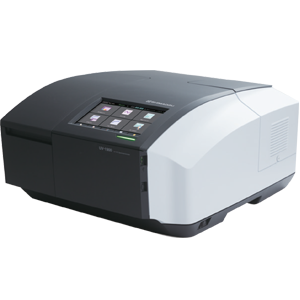
The UV-1900 is a double-beam UV-Vis spectrophotometer using Shimadzu's original LO-RAY-LIGH™ diffraction grating technology. In addition to its high optical performance, the UV-1900 features high resolution, low stray light, high reproducibility, and an ultra-fast scan function. It also has an easy-to-use interface on a color touch-screen display. The UV-1900 is designed to meet the needs of both high performance and usability.
Hardware Specifications (UV-1900)
| Item | Specification |
| Wavelength range | 190 to 1,100 nm |
| Spectral bandwidth | 1 nm (190 to 1,100 nm) |
| Wavelength display | 0.1nm increments |
| Wavelength setting | 0.1nm increments (1nm increments when setting scanning range) |
| Wavelength accuracy | ± 0.05 nm at D2 peak 656.1 nm, ± 0.3 nm for entire range |
| Wavelength repeatability | ± 0.1 nm |
| Wavelength slew rate | About 14,500 nm/min |
| Wavelength scanning speed | 3,000 to 2 nm/min |
| Lamp interchange wavelength | Automatic interchange linked to wavelength. The interchange wavelength can be set freely in the range of 295 to 364 nm (0.1nm increments). |
| Stray light | Less than 0.02% at 220 nm (NaI) Less than 0.01% at 340 nm (NaNO2) Less than 0.5% at 198 nm (KCl) |
| Photometric system | Double beam optics |
| Photometric range | Absorbance: -4 to 4 Abs Transmittance: 0% to 400% |
| Photometric accuracy | ± 0.002 Abs at 0.5 Abs ± 0.0025 Abs at 1.0 Abs ± 0.006 Abs at 2.0 Abs (measured using NIST930D/NIST1930 or equivalent.) |
| Photometric repeatability | Less than ± 0.0001 Abs at 0.5 Abs Less than ± 0.0001 Abs at 1 Abs Less than ± 0.0005 Abs at 2 Abs |
| Item | Specification |
| Baseline stability | Less than 0.0003Abs/hr (700 nm, one hour after light source turned ON) |
| Baseline flatness | Less than ± 0.0006 Abs (1,100 to 190 nm, one hour after light source turned ON) |
| Noise level | Less than 0.00003 Abs (700 nm) |
| Light source | 20-W halogen lamp and deuterium lamp Built-in light source auto position adjustment |
| Monochromator | LO-RAY-LIGH grade blazed holographic grating in Czerny-Turner mounting |
| Detector | Silicon photodiode |
| Sample compartment | Internal dimensions: W110 × D250 × H115 mm Distance between light beams: 100 mm |
| Power requirements | AC100,120,220,230,240 V, 50/60 Hz, 140 VA |
| Environmental requirements | Temperature: 15°C to 35°C Humidity: 30% to 80% (without condensation; 70% max. at 30°C or higher) |
| Dimensions | W450 × D501 × H244 mm |
| Weight | 16.6 kg |
| Output device | USB memory (optional) |
| Data files saved in text format or UVPC format. UVPC-format files can be read directly by UVProbe and LabSolutionsTM UV-Vis. | |
| PC compatibility | UVProbe software (standard) LabSolutions UV-Vis software (optional) External control possible via USB. |
| Display | 24-bit color touch screen |
| Supported languages | Japanese, English, Chinese, Spanish (Mexico), Portuguese (Brazil). |
UV-1900 Software Specifications
| Measurement mode | Specification |
| Photometric mode | Single-wavelength measurement
Multiple-wavelength measurement
|
| Spectrum mode |
|
| Quantitation mode |
|
| Kinetics mode |
|
| Time scan mode |
|
| Measurement mode | Specification |
| Biomethod mode | DNA/Protein Quantitation
Quantitation of proteins
|
| Maintenance |
|
| Shared functions |
|

